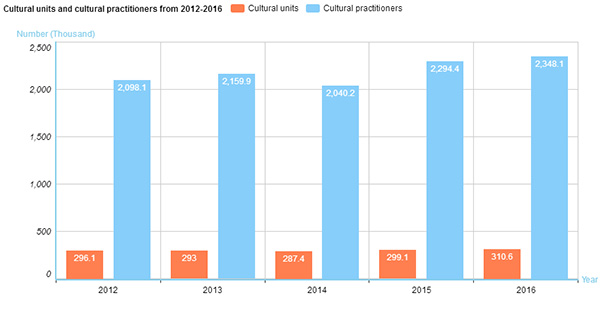
Fuelled by multiple factors, including economic transformation, strong government support, a broad internet access which allows for content creation and people's diversifying leisure demands, creative industries in China have witnessed a significant boost in recent years.
The Annual Research Report on Cross-Strait Creative Economy (2016) compiled by Xiamen University of Technology and National Taipei University of Education in Taiwan shows that China's creative economy has been quite competitive in the world.
The statistics show that in 2015, the cultural creative industry in Chinese mainland got an added value of 2.58 trillion yuan. While in 2014, the global export of cultural creative products was valued at $600.3 billion, out of which, the export of Chinese mainland surpassed $200 billion, occupying a market share of 33.71 percent in the world, taking the first spot.
The table above shows the number of cultural units and cultural practitioners from 2012 to 2016. The graph reveals that the cultural units and cultural practitioners witnessed an overall growth in numbers.
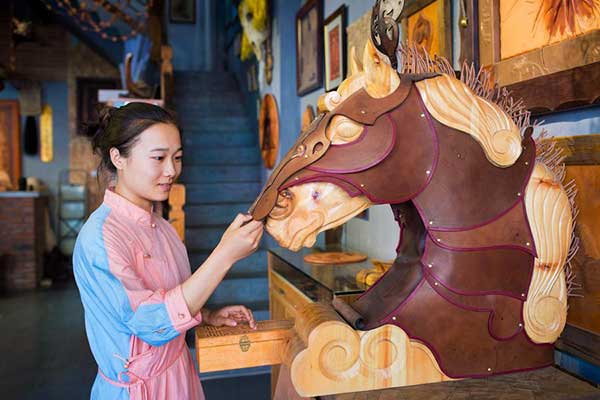
1. Related policies and regulations
A national guidance to promote public cultural services system was published by the State Council on Oct 20, 2015, as a way of stimulating and accelerating the development of institutions such as museums, libraries and cultural centers. In 2016, the Ministry of Culture, collaborating with other departments, formulated the Cultural Industry Promotion Law (draft version to solicit opinions).
A guidance on promoting the creative development of digital cultural industry was issued by the Ministry of Culture on April 11, 2017.
On May 16, 2017, Ministry of Culture, National Development and Reform Commission, Ministry of Finance and the State Administration of Cultural Heritage jointly released Suggestions on the Promotion of Cultural and Creative Products of Cultural and Cultural Relics Institutions, which was later promoted by the State Council. The Suggestions defines the concept of the above-mentioned cultural and cultural relics institutions. Namely, it includes museums, galleries, libraries and cultural centers of all types at all levels in China.
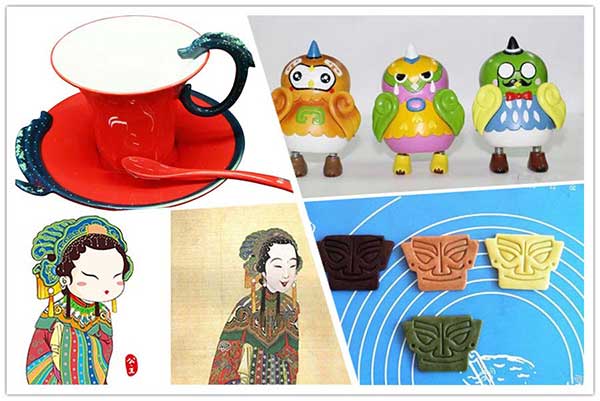
2. Cultural creative products in museums
According to Vice-Director Guan Qiang of the State Administration of Cultural Relics, the total sale generated by 9 museums jointly built by the central and local governments was 97 million yuan ($15 million) in 2015.The revenue of each level of museum varies. Prefecture-level museums display more creative products than county ones.
According to the magazine Art Market, by the end of 2016, out of the 4,526 museums in China, 2,256 were recognized by the nation as museums that had the capabilities to develop cultural creative products on mass scale.
The Palace Museum's creative endeavor began in 2007 when it produced souvenirs for the 2008 Beijing Olympics. Over the next decade, it produced more than 9,600 items featuring the imperial palace and its exhibits - silk scarves, for instance, in the patterns of emperors' dragon robes, or Chinese checkers sets drawing their inspiration from the roof. The museum boasts nearly 2 million antiques in its collection.
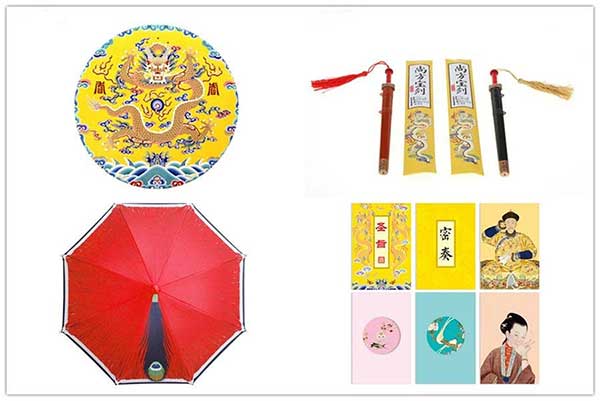
By the end of 2016, the Palace Museum in Beijing had developed a total of 9,170 kinds of creative products that generated a revenue of around 1 billion yuan ($153 million) in 2016.
The National Museum of China, one of the largest museums in the world, began a similar project in 2011. The museum has come up with more than 3,000 products, and it had racked up 2.3 billion yuan ($334 million) in souvenir sales as of 2016.
The National Library of China, which has a massive collection of books, has designed a series of cultural creative products inspired by ancient classics.
Not only national-level museums, local museums are also racking their brains to develop cultural creative products, such as Suzhou Museum's delicate wooden supporting frame, Taiyuan Art Museum's "angry birds" shaped money box and Sanxingdui Museum's special made cookies based on its collections of mysterious bronze masks.
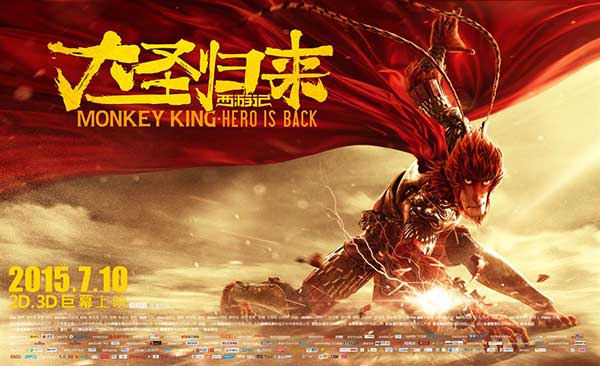
3. Animation industry and online games
Due to the supportive government policies and the various emerging internet-based new media channels, Chinese animation industry is now experiencing an unprecedented growth. According to a report released at the China International Cartoon and Animation Festival this year, animated movies earned 7 billion yuan ($1 billion) at China's box office last year, or around 15 percent of the national total and the figure was up 45 percent from 4.5 billion yuan in 2015.
In recent years, Chinese animation films and series are trying to break new ground. The 2015 animation film Monkey King: Hero Is Back, which was an adaptation based on the classic novel "Journey to the West", became the highest-grossing animation film (950 million yuan) in the country before Zootopia came out the following year, making it a landmark in China's animated film history.
And in 2016, another animation movie Big Fish & Begonia, rooted in Chinese mythology and inspired by ancient architecture, took 560 million yuan. Although challenges from powerful foreign players still exist, the rise of domestic animation movies in the two or three years clearly indicate that the country is increasingly interested in cartoons and has the right talent and creative potential to satisfy the audience.
The robust growth of Chinese animation industry is not manifested in the development of animated films, but also in the derivatives market such as animation toys and online games. Online entertainment has witnessed an unprecedented market boom as an entire generation has now grown up immersed in the ever more realistic virtual worlds brought about by the gaming industry, which is deemed as a revolutionary force in the new entertainment era propelled by technological advancements.
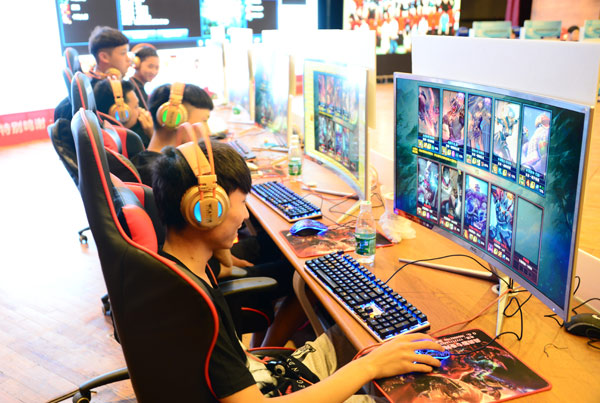
Game enterprises are one of the major winners of the top cultural enterprises in the country, according to the latest "National Top 30 Cultural Enterprises" list released on May 11, 2017. Domestic game market, especially the mobile games sector, has witnessed a steady growth over the last decade. According to the 2016 China Game Industry Report, the total sales venue of the domestic game market reached nearly 166 billion yuan, which was 17.7 percent up compared with the previous year.
One of the best performers is Tencent's hit game King of Glory, which defeated all other mobile games in the world to take the No 1 spot in income generation, according to a report released by APP Annie, a US-based analysis company. Not only is it the most profitable game in the world, the rich cultural connotation embodied in the game is also a highlight.
The majority of the characters in the video game are based on Chinese historical figures, and given that the game has gained an international fame for its popularity, it has prompted curiosity among foreign players to learn more about Chinese culture. And this has led to the discussion on to what extent can game products carry more functions, such as engaging in cultural exchanges.
Another noteworthy case is Dota 2, the latest version of this Western game product has incorporated Monkey King, a Chinese classic cultural image, as one of its heroes, which may also act as a spur to attract Western players' attention onto Chinese classic literature.
When it comes to cultural creativity, content is the only thing that matters. Using classic Chinese cultural elements as source material and incorporating them into today's popular entertainment mode has been proved to be an effective tool in both upgrading the leisure business and promoting cultural exchanges with other countries.
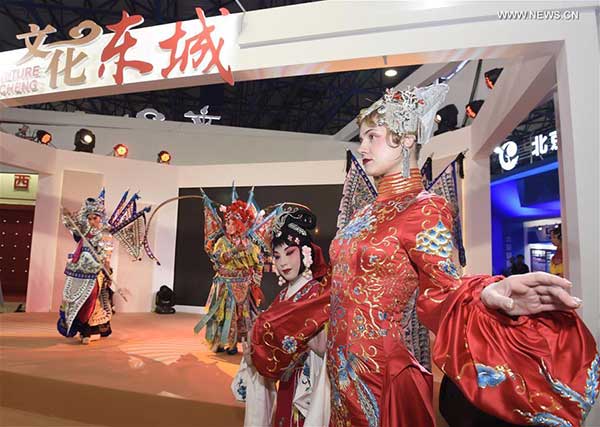
4. Cultural creative expos held nationwide
From the provincial level to the national level, various cultural expos are held nationwide during recent years, displaying China's constant progress in cultural creative industries.
More institutions are using the platform of cultural expos to release new products and new technologies, and stick to forge cultural brands continuously.
According to ccitimes.com, the top 10 cultural expos in China in 2016 are as follows: The 12th China (Shenzhen) International Cultural Industries Fair; The 9th Cross-Straits (Xiamen) Cultural Industries Fair; The First Silk Road (Dunhuang) International Cultural Expo; The 11th China Beijing International Cultural and Creative Industry Expo; The 6th China (Wuxi) International Culture and Art Industry Fair; The 6th Shandong Cultural Industries Fair; The 4th China Intangible Cultural Heritage Expo; The 5th China Suzhou Creative and Design Cultural Industry Expo; The 10th Hangzhou Cultural and Creative Industry Expo; and The 11th China (Yiwu) Cultural Products Trade Fair.
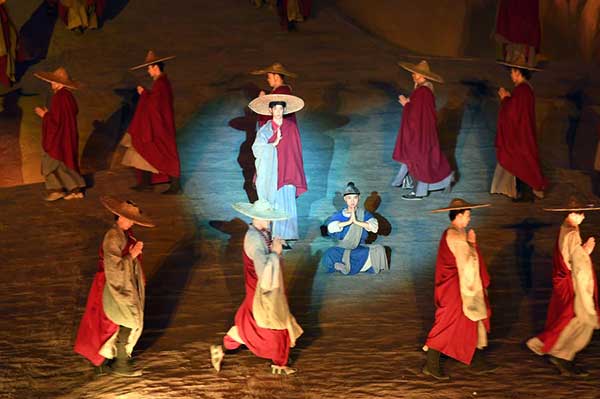
The 12th China (Shenzhen) International Cultural Industries Fair achieved a trading volume of 203.2 billion yuan, and was honored as the "No 1 expo in China's cultural industry".
The 9th Cross-Straits (Xiamen) Cultural Industries Fair has organized 107 special activities spread over 30 parallel sessions around Xiamen, with a total of 135 experts, scholars and entrepreneurs delivering speeches at site. It ranks the second.
The First Silk Road (Dunhuang) International Cultural Expo has achieved a contract value of 107.8 billion yuan, including film and television, culture creativity, culture technology and culture tourism. A total of 95 foreign delegation groups from 85 countries and 5 international organizations attended the expo. It ranks the third.
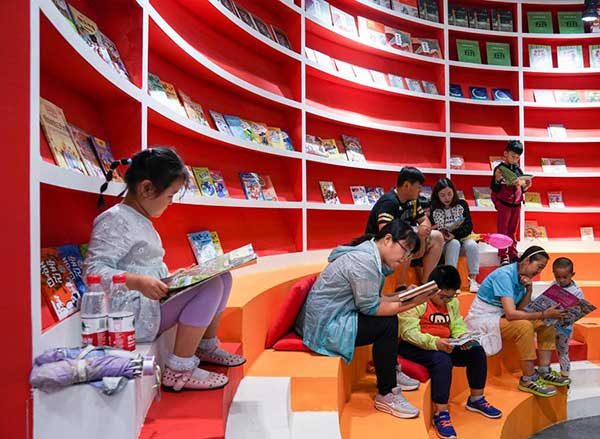
5. Publishing industry got transformed
Chinese nationals'digital reading rate has risen to 64 percent, surpassing 5.6 percentage points comparing to paper reading, and among them, 60 percent adults read on the phone at least once, according to the 2016 Beijing International Publishing Forum.
An annual report on China's digital publishing industry 2016-2017 shows that the general income from the digital publishing industry in China in 2016 was more than 570 billion yuan, an increase of 29.9 percent compared to 2015. It also shows that online literature shows a robust growth, digital education publishing achieves major breakthroughs, and audible reading material becomes a new growth point.
By the end of 2016, there were 333 million online literature readers, accounting for 43.3 percent of the total number of netizens in China, according to Beijing Municipal Bureau of Press, Publication, Radio, Film and Television. Among them, 304 million users access literature through mobile phones.
Over the last 20 years, China's online literature industry has registered explosive growth, with an annual growth rate of 20 percent.
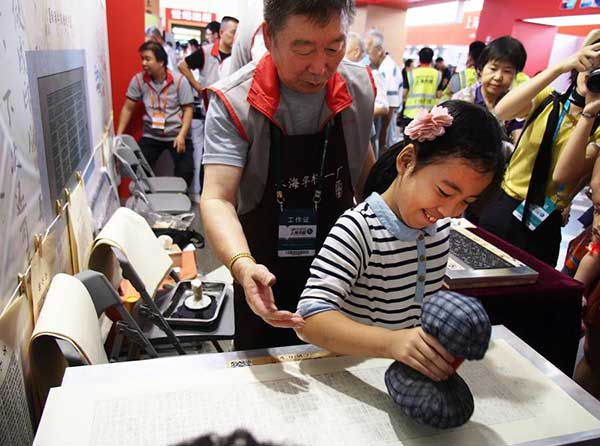
Online literature has become a no small power in cultural creative industries, as more people turn to read novels online and more well-acclaimed literary works are produced by online writers. There is also a boom in TV drama adaptations of online literature, such as most-watched TV dramas The Journey of Flower, The Lost Tomb, Nirvana in Fire.
Though paper books and traditional bookstores are seemingly getting away from our lives, actually they are still indispensable part of our lives. Under the impact of internet and new technology, many bookstores and publishing houses are also transforming their style and designing their distinctive cultural creative products.
For example, during the Shanghai Book Fair, Xiaofeng Bookstore, with its antique-flavor furniture and decorations, as well as cultural products possessing strong local style, attracted lots of visitors. After getting authorization from Chinese literary figure Feng Zikai's families, it has developed various products such as brush pot, bookmark, and tea cup themed on Feng Zikai.
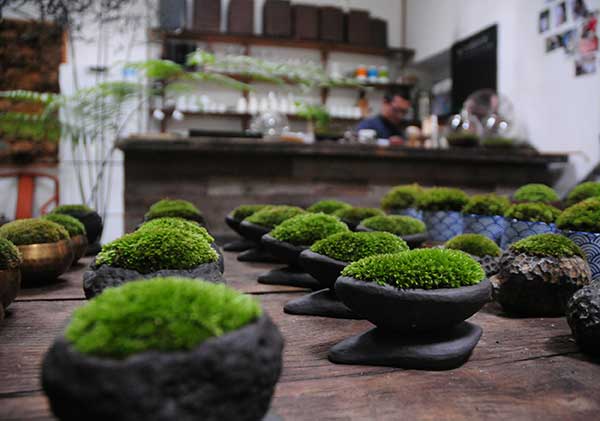
6. Culture tourism
Cultural tourism has increasingly become a booming sector in the global tourism landscape. Implementation Opinions of the Ministry of Culture on Implementing the Several Opinions of the State Council on Further Promoting the Integrated Development with Relevant Industries of Cultural Creativity and Design Services, released by the Ministry of Culture in 2014, proposes that cultural creativity should be injected into tourism, and travel products could be upgraded by commercialization of cultural tourism.
In recent years, culture and creative industries are widely used around the world to enhance attractiveness and competitiveness of tourist destinations. Tangible and intangible cultural heritage of a location can be creatively crafted to suit modern-day travelers, who are more or less tired of the traditional sightseeing and want to be fully immersed in local cultural traditions and lifestyles.
Take the Waitongwu village in Hangzhou, for instance, the village boasts a rich Longjing tea culture and has been known since ancient times as home to "loads of Longjing tea". Now the village uses it tea culture as a competitive edge and has developed a big cultural tourism brand by dividing the village into 6 functional areas, including tea art appreciation area, tea garden sightseeing area, farmyard leisure area etc.
Every year, when it is time for tea picking, tourists can come and fully participate in the picking experience and later take part in the annual tea frying competition, which is another highlight of the village.
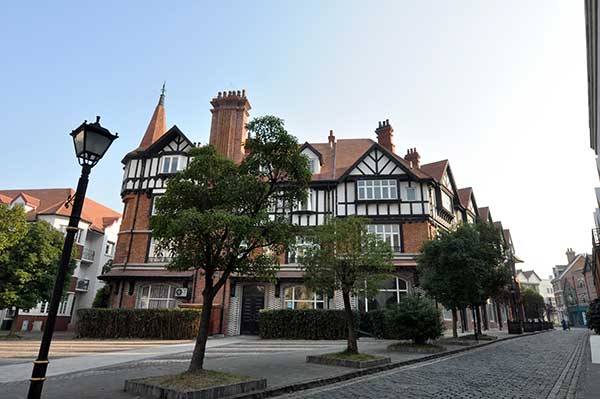
The integration of tourism and creative industries can be achieved in many ways, theme parks, art streets and blocks, tourism performance art etc. The 798 Art Zone is a fine example, which has successfully turned vacant factories into a thriving artistic community and can best exemplifies how art, culture, creativity and tourism can be integrated into a travel brand. The shabby streets have been creatively transformed into unique architectural complex, where you can find SOHO style art hubs and a good number of avant-garde art exhibitions.
Another good example is the Thames Town in the Songjiang district of Shanghai. Opened in 2016, the town was built to resemble a quaint British neighborhood, complete with red-brick cottages and chimneys, a chapel, a covered bridge and shuttle buses that resemble steam trains. It is not a simple replica of the Thames riverside, what it aims for is to provide visitors with an authentic British experience in an ecological environment where people, nature and architectures are in a truly harmonious state.